The State of Influencer Marketing: 10 Influencer Marketing Statistics to Inform Where You Invest
Rochelle Bailis


The State of Influencer Marketing: 10 Influencer Marketing Statistics to Inform Where You Invest
Get The Print Version
Tired of scrolling? Download a PDF version for easier offline reading and sharing with coworkers.
A link to download the PDF will arrive in your inbox shortly.
Over the last two decades, social media has become an integral part of people’s lives—and a crucial way for brands to reach new audiences.
As more users joined social media platforms like Facebook, Youtube, Instagram, Pinterest, Snapchat, and Twitter, many of them became content creators themselves, curating and crafting their own stories, photos, and videos for others to see.
This is how social media influencers were born, and quickly attracted the attention of marketers.
Over the last five years, brands have collaborated with social media influencers across channels to generate awareness, and influencer marketing grew from an ancillary marketing tactic to a $5-10 billion dollar industry.
In spite of this, many small businesses remain uncertain about influencer marketing and whether to invest in it as a channel.
So does influencer marketing really work?
Today, influencer marketing is more accessible and measurable than ever before, and more marketers report finding it effective in achieving their goals.
Here are 11 powerful influencer marketing stats curated to inform your marketing strategy this year, based on a 2019 survey of marketers by Mediakix, an influencer marketing agency.
What is Influencer Marketing?
In order to understand influencer marketing, you need to understand influencers.
A social media influencer is someone who has built a loyal following through their online content creation.
Influencer marketing is when companies partner with influencers in order to increase brand awareness or conversions among a specific target audience.
Marketers accomplish this through sponsoring an influencer’s online content, with the goal of endorsing their brand, product or service, and in some cases, drive purchases.
The reason many companies struggle with influencer marketing is not that the channel doesn’t work, it’s often because their sponsored content is not thoughtfully planned, executed or authentically aligned with the audience.
“When you want to really scale and when you want to reach new audiences, you need content that makes people WANT you — and that comes from having great content.
One of the best ways to get this content is from influencers – they know how to tell a story that fits the social media channel’s objective.” — William Harris, Founder & CEO at Elumynt.
Many factors can negatively affect the performance of an influencer marketing campaign. Here are just a few:
Selecting influencers who aren’t aligned with your brand, or wouldn’t normally use your product.
Not evaluating the influencer’s target audience alignment before partnering up.
Pushing a rigid script on the influencer, rather than collaborating on a creative approach they feel will resonate with their fans.
Failing to set clear terms and timelines for your agreement.
Publishing blatantly promotional, hard-selling content that turns off fans.
Not setting up proper tracking, URLs or landing pages beforehand.
The fact is, when executed correctly, influencer marketing works for a wide range of companies—and the data backs this up.
10 Most Important Influencer Marketing Statistics for 2020
Influencer marketing is gaining more traction and investment than ever before.
The majority of marketers plan to increase their marketing budgets this year, and Instagram is rapidly becoming the most widely-used channel in the industry.
Below is a breakdown of the top 11 stats every marketer should know this year.
1. 65% of influencer marketing budgets will increase in 2020.
Nearly two-thirds of marketers will increase their spending on influencer marketing this year.
In 2018, only 39% of marketers planned to grow their influencer marketing budget, suggesting that brand investment in influencer marketing will increase dramatically this year.
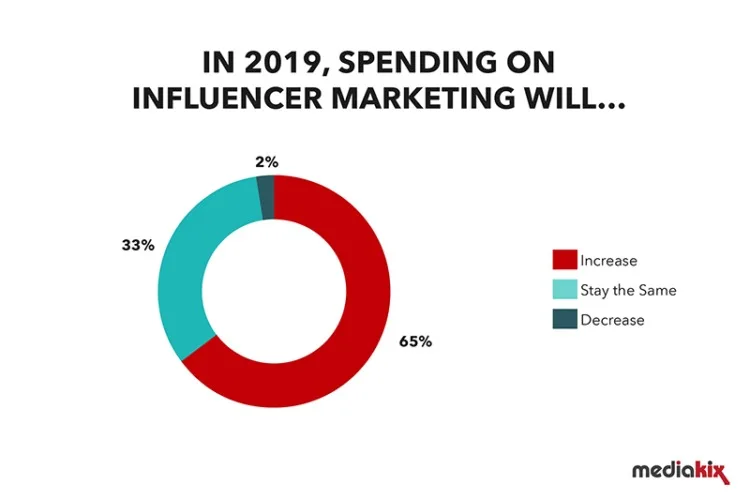
2. The most common influencer budget is $1,000 – $10,000/year, followed by $100,000 – $500,000/year.
19% of marketers will spend $1,000 – $10,000 per year on influencer marketing in 2020, while 18% are spending between $100,000 – $500,000 per year.
7% of companies plan to invest over a million dollars in influencer marketing in 2020.
This suggests that influencer marketing is leveraged by a range of companies, from smaller organizations to much larger brands.
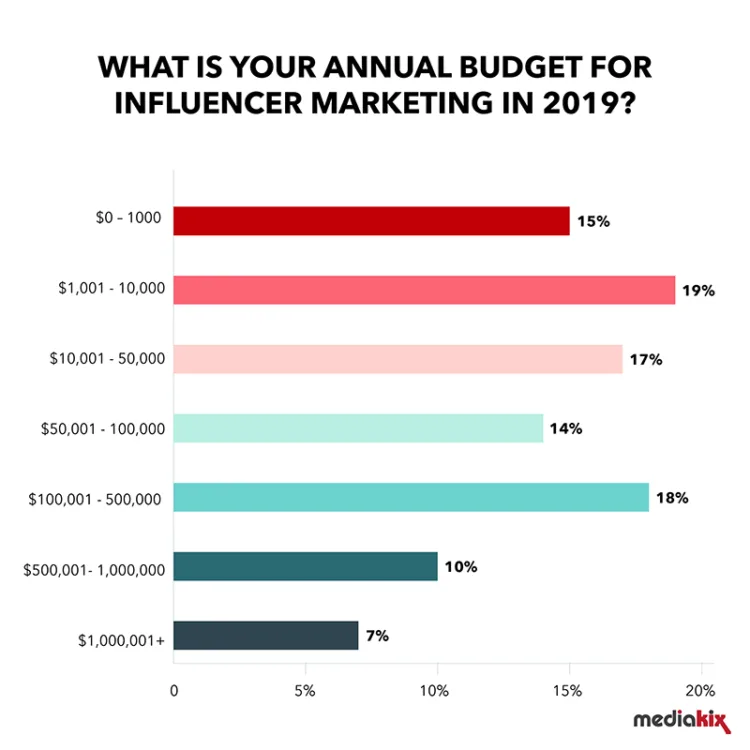
3. 17% of companies spend over half their marketing budget on influencers.
A small but not insignificant percentage of marketers—17% of them—plan to spend over half of their entire marketing budget on influencer marketing this year.
While this percentage is modest, it highlights how pivotal influencer marketing has become for a handful of companies, particularly ecommerce, fashion and beauty, gaming, travel and lifestyle brands.
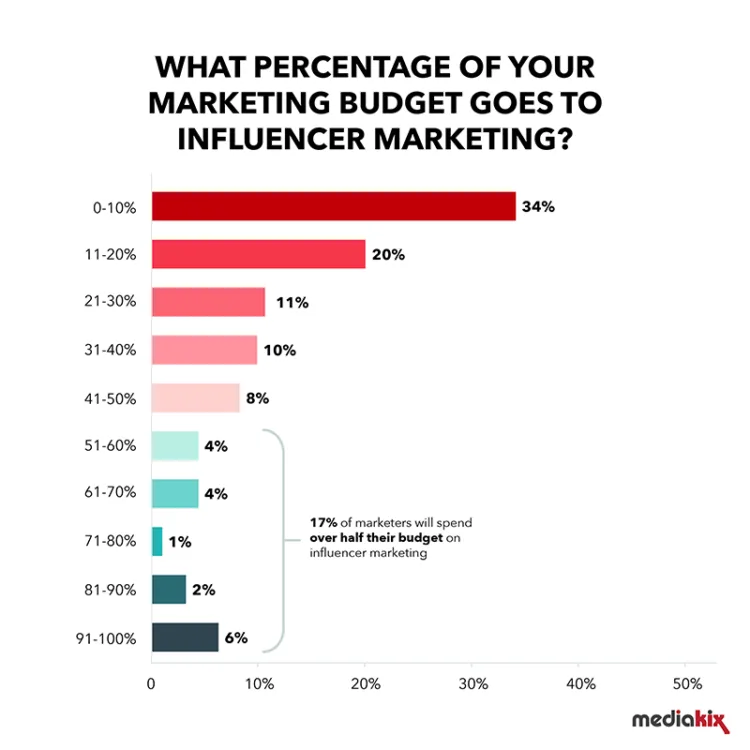
4. 89% say ROI from influencer marketing is comparable to or better than other marketing channels
Generating positive influencer marketing ROI (return on investment) remains top of mind for many marketers in 2019.
Many small business owners are understandably wary about investing in an emerging channel if it can’t generate quantifiable results.
However, nearly 90% of all marketers find ROI from influencer marketing comparable to or better than other marketing channels.
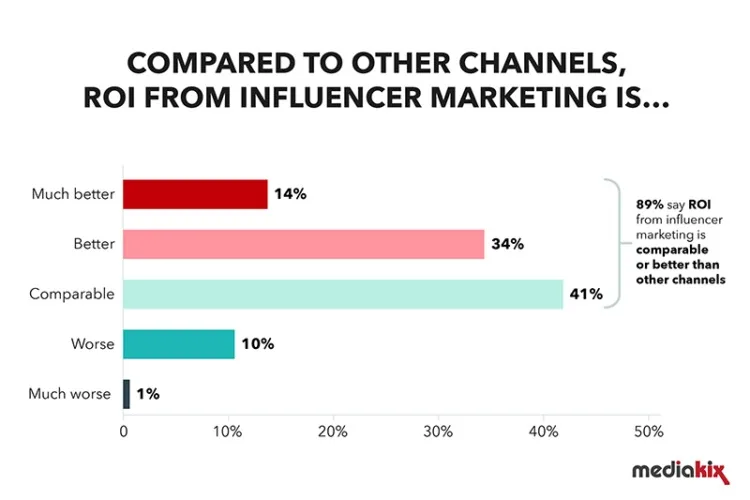
5. Instagram ranks #1 for the most important and impactful channel.
Moving into 2020, Instagram has become a social media powerhouse.
With over 1 billion users and a fast-growing network of influencers churning out millions of sponsored posts each year, Instagram has become the most important influencer marketing channel.
While more established channels like Facebook and YouTube remain popular, the ease of photo-sharing on Instagram spawned a huge variety of influencers with a direct line to different niche audiences.
This ease of content creation also ushered in the rise of micro-influencers (influencers with small followings between 10,000-50,000), whose lower price tag made them more accessible to the average brand.

6. Snapchat is the least preferred channel for influencer marketing.
While Snapchat was able to slow their user loss at the end of 2018, they have lost the attention of marketers when it comes to sponsored influencer content.
Early on, Snapchat’s functionality made it difficult for fans to find specific influencers and the platform didn’t provide influencers with enough audience data to attract brands for sponsorship.
The platform has mended many of these feature limitations, but Instagram Stories has already overtaken Snapchat Stories with over double the number of daily active users.
This puts Snapchat at the very bottom of most marketers’ lists when it comes to influencer marketing in 2020.
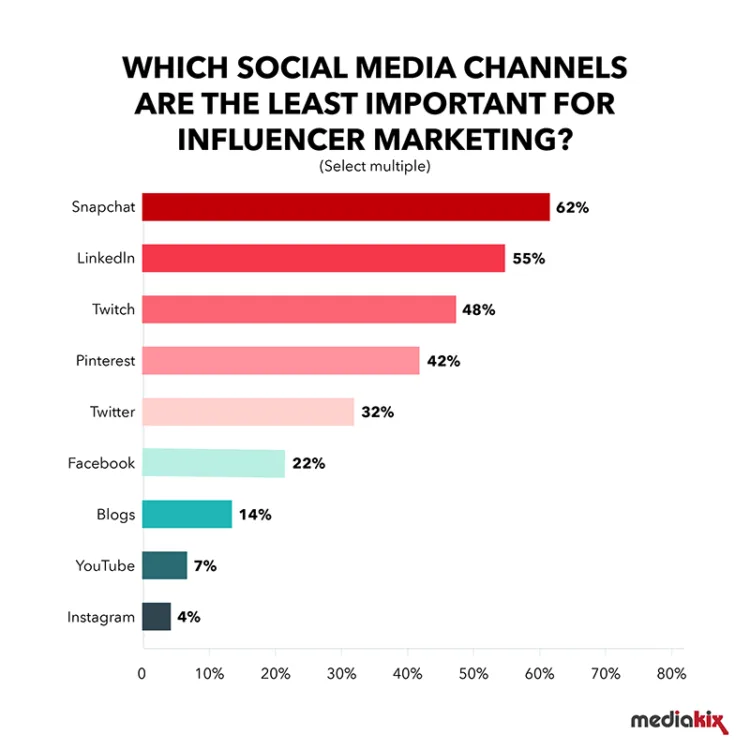
7. Over ⅔ of marketers will spend the most on Instagram.
Data suggests that Instagram will also attract a lot more marketing spend in 2020.
69% of marketers plan to spend the most money on Instagram for influencer marketing this year.
That’s over six times more than YouTube (11%), the second most-selected channel for top spend.

8. Instagram posts are the most used format of influencer marketing.
When asked to pick the content formats they find effective for influencer marketing, 78% of marketers chose Instagram posts—the #1 choice.
Sponsored Instagram posts have become ubiquitous because they are easy to produce, approve, and publish, therefore easy to scale up.
Compared to videos or longer-form content, a single photo and caption requires relatively less production cost and effort, making it a more affordable option for small companies looking to test Instagram influencer marketing.
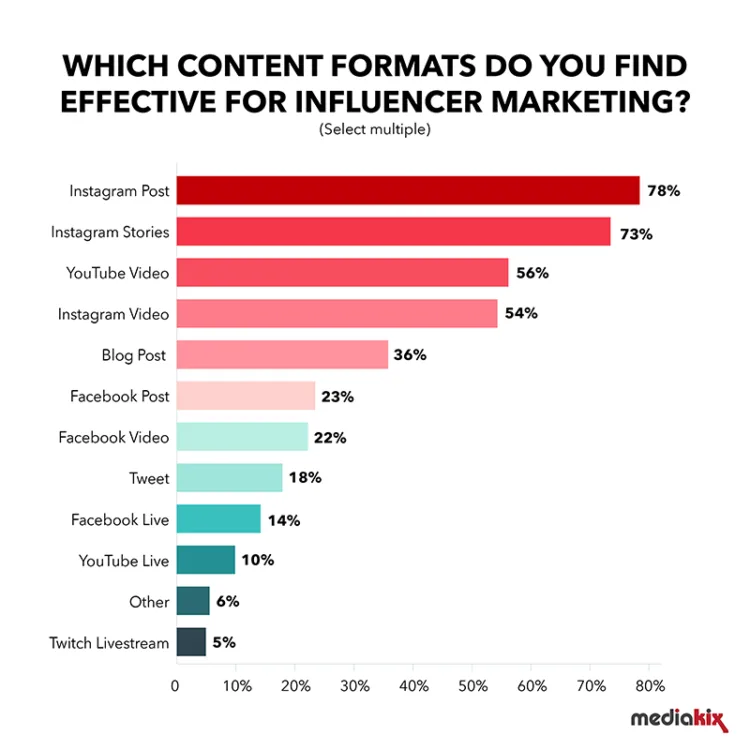
9. Instagram stories are the second most used format, followed by YouTube videos and Instagram videos.
Instagram Stories rank as the second most popular content format for influencer marketing, after Instagram posts.
Stories originally gained popularity with Snapchat, and today over 500 million Instagram users use Stories every day.
Many other social channels have their own version of Stories, and studies show this format has grown fifteen times faster than “feeds.”
Users respond positively to Stories because they perceive this impromptu swipe-able montage series to be less staged, more authentic, and easier to navigate.
Video formats are also popular, with YouTube videos and Instagram video ranking high on the list of effective formats for influencer marketing.

10. Twitch livestream ranks as the least used channel.
In the list of most effective content formats, Twitch livestream was the least selected by marketers in 2020.
Twitch is an emerging livestreaming platform that pulls over 15 million daily active users, largely gamers.
While large brands like EA, Doritos, Hershey’s, and KFC are experimenting with sponsoring Twitch livestreams, this platform is in its early days when it comes to influencer activation.
Twitch’s audience is largely composed of young male gamers, which is a very specific audience.
However, the platform is expanding into other categories, such as Art, Talk Shows, Music and Food & Drink, and may soon be pushing into other verticals.
Stay tuned in future years to see how the platform evolves.
Top 5 Goals of Influencer Marketing
Before embarking on an influencer marketing campaign, it’s important to be crystal clear of your goals.
Generally, target key performance indicators (KPIs) for brands fall into two camps:
Brand awareness: metrics tied to increased audience awareness of your product or service, such as content impressions, likes, comments, mentions, reach and traffic.
Direct response: metrics tied to specific actions, such as clicks, sales, conversions, leads, downloads and subscribers.
Some influencer marketing campaigns fall into both camps, driving engagement as well as some form of conversion.
Here are the top five influencer marketing goals cited by marketers:
1. Increase brand awareness.
The most popular goal for influencer marketing campaigns is building awareness around a brand, product or service.
Brand awareness is generally measured through impressions, reach and engagement metrics.
2. Reach new audiences.
Influencers should be able to share their audience data (age, gender, location, interests, etc.) to help ensure alignment with your target audience.
3. Generate sales.
More influencer campaigns today are aimed at driving tangible sales, which can be clearly tracked using custom links, landing pages and redemption codes.
Remember to have all these elements in place before launching your campaign to ensure accurate measurement.
4. Improve brand advocacy.
Influencers can provide strong validation and spark word-of-mouth conversations about your product or brand amongst their fans.
5. Drive lead generation.
Aside from sales, new leads are another popular direct response metric for influencer marketing campaigns. Names and emails can be collected through newsletter subscriptions, account setups, or giveaway entries.
Pro Tip
Avoid using too many calls-to-action (CTAs) in a single sponsorship — this often causes audience confusion and can negatively affect performance across all target KPIs.
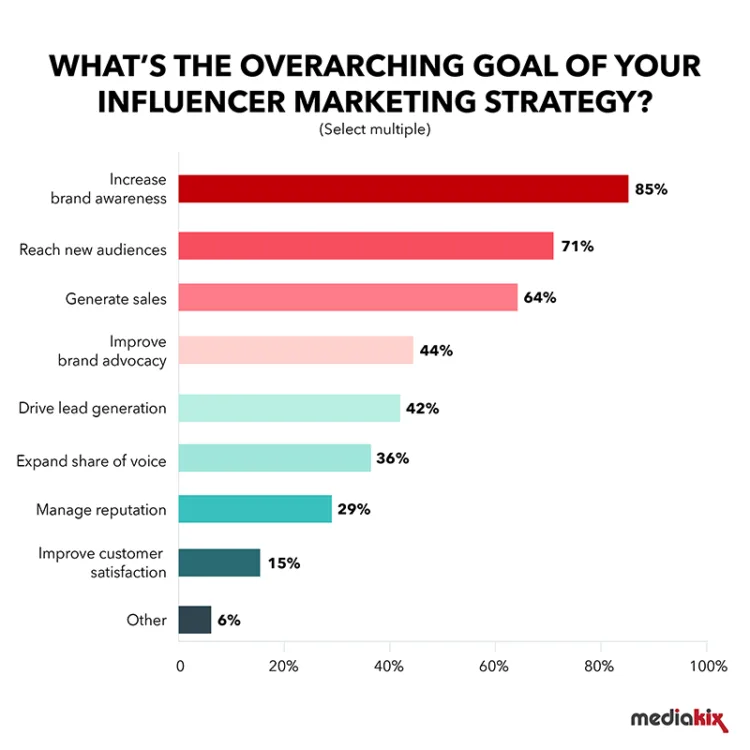
What Makes a Quality Influencer?
If you don’t partner with the right influencers, the campaign is doomed to fail from the start.
61% of marketers agree it’s challenging to find the best influencers for a campaign, suggesting this problem is far from solved.
What are the most important criteria to look out for?
Here are the top 5 things marketers look for when deciding the best influencers to work with:
1. Quality of content.
Before working with an influencer, review their content and compare it to others in their industry. According to Ryan Robinson’s recent blogging statistics, 65% of content marketers say they have a documented content marketing strategy in place, meaning 35% have room to improve.
Is their sponsored content thoughtful and creative, or is it comprised of quick shout outs or product placements thrown in without much thought?
2. Target audience.
Even if an influencer has great content, it’s crucial to confirm that the influencer’s audience profile aligns with the demographics you’re targeting for your campaign.
3. Engagement rate.
Engagement is by far the most common metric used for measuring influencer marketing success, measured by 75% of marketers for influencer marketing.
The engagement rate of a post is calculated by adding up engagement (likes, comments, etc.) and dividing it by the influencer’s total number of followers.
Note that engagement rates for sponsored content will almost always be lower than on organic posts.
4. On-brand messaging.
Evaluate whether the influencer’s voice and aesthetic line up with your brand’s style.
It’s also important to research any past controversies and keep an eye on their language to identify whether anything throws up red flags regarding brand safety.
5. Budget.
Clearly, an influencer needs to be within your price range.
Remember to consider influencer fees, production costs, product costs (if you plan to ship them a sample) and any platform or influencer agency fees when calculating your overall budget.
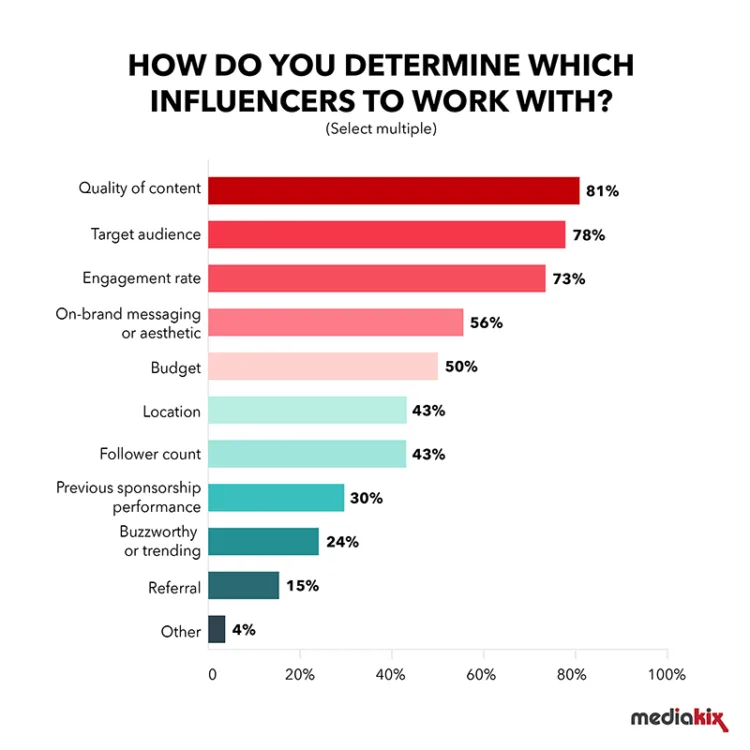
The Biggest Influencer Marketing Challenges
While many marketers are finding success in influencer marketing, many still need to tackle these common challenges:
1. Spotting fake followers and inauthentic engagement.
Although Instagram has cracked down on third party services that peddle in fake followers and inauthentic engagement, it appears that marketers remain skeptical about the scope or effectiveness of this ban.
Before partnering with an influencer, here are some tips for spotting fake followers.
2. Social algorithms making content less visible.
Social media platforms have changed the algorithms of their users’ feeds since the social feed was created—but in recent years algorithm changes have stirred up influencer communities.
For example, in September 2018 YouTube came under fire for their algorithm changes supposedly leading to creator burnout, as influencers raced to produce more content so their videos wouldn’t drop from the feed.
Many brands, too, feel that their organic social content ends up being lost after algorithms deprioritized it.
That being said, influencer content tends to surface well amongst fans on most platforms, which is why more brands are investing more in sponsoring influencer content.
3. Building an always-on strategy, rather than one-off campaigns.
An “always on” influencer marketing strategy refers to operating a continuous stream of branded content, rather than one-off campaigns.
While more marketers find “always on” strategies effective, they require a lot of internal resources to maintain.
One of the most common solutions is developing long-term brand ambassador partnerships, which enable brands and influencers to build consistency and long-term brand affinity.
4. The rising costs of influencers.
There’s no question that the most popular macro-influencers and celebrities have increased their pricing in recent years.
For example, Kylie Jenner charges a whopping $1 million per sponsored Instagram post. However on the other end of the spectrum, marketers are exploring partnering with smaller, more accessible influencers such as nano-influencers, who will often work for a nominal fee or in exchange for a free product.
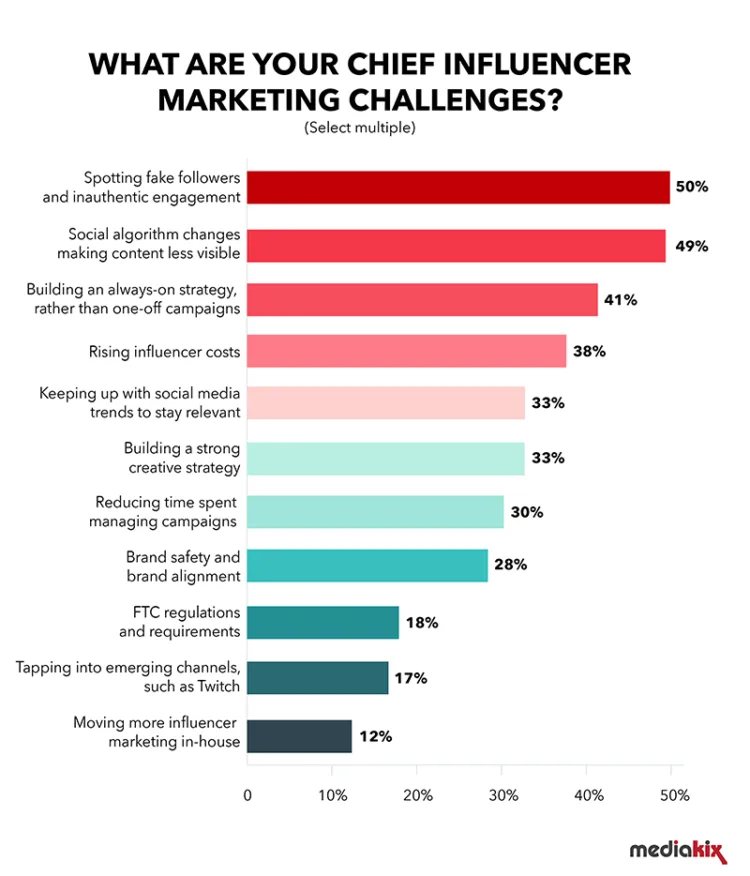
Key Takeaways on Influencer Marketing for 2020
As we move through 2020, influencer marketing shows no signs of slowing.
As more marketers dabble in this fast-growing channel, here are a few key stats to keep in mind:
Marketers find influencer marketing effective, and are upping their budget in 2020.
Whether your goal is to increase brand awareness, sales or reach new audiences, always set clear KPIs (and tracking) beforehand.
Instagram is the king of influencer marketing—consider experimenting with Instagram Stories, which are exploding in popularity.
Take your time finding the right influencers. Look for quality content, on-brand voice and audience alignment.
Look out for signs of fake influencers or inauthentic engagement, as signs suggest this issue isn’t going away.
Conclusion
The fact is, influencer marketing isn’t going anywhere.
While influencer marketing may not be right for every single brand or company, the best way to know is to test.
Rather than running a couple one-off campaigns and seeing what happens, take the time to set very clear goals, target KPIs and budget.
Look at how others in your industry approach influencer marketing, which of their sponsored content performed well and why.
Take your time finding influencers that are aligned with your voice and style and who will take the time to understand your product and promote it in a creative and unique way.
If you’re looking for help building your influencer marketing strategy, consider partnering with an influencer agency or leveraging managed services offered through an influencer platform.

Rochelle Bailis is the VP of Marketing at Mediakix, and influencer marketing agency that conducts leading research about the rapidly-evolving influencer marketing industry. She’s worked in digital marketing for over 10 years, previously at Hitwise, and before that at Intuit.


